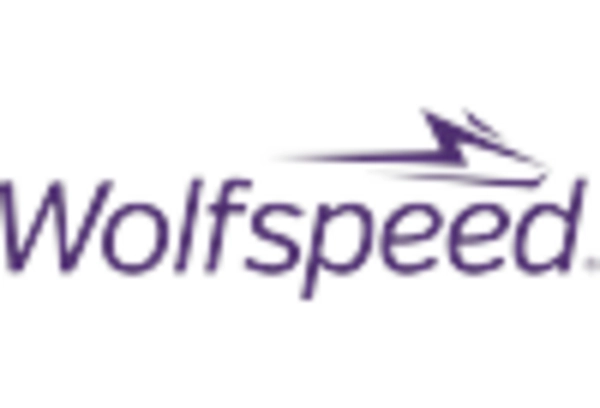China : Unmatched Growth and Demand Trends
Key cities such as Shenzhen and Shanghai are pivotal in the silicon carbide landscape, hosting major players like Cree Inc and ROHM Co Ltd. The competitive landscape is characterized by a mix of domestic and international firms, fostering innovation and collaboration. Local market dynamics are influenced by a robust supply chain and a growing emphasis on high-performance applications in sectors like telecommunications and power electronics. The business environment is increasingly favorable, driven by investments in R&D and technology advancements.
India : Rapid Growth in Semiconductor Sector
Cities like Bengaluru and Pune are emerging as key markets for silicon carbide, with a burgeoning ecosystem of startups and established firms. The competitive landscape features players like Infineon Technologies and STMicroelectronics, who are investing in local production capabilities. The business environment is dynamic, with increasing collaborations between industry and academia to foster innovation. Applications in power electronics and electric vehicles are gaining traction, positioning India as a significant player in the silicon carbide market.
Japan : Innovation and Quality at Forefront
Key cities such as Tokyo and Osaka are central to Japan's silicon carbide market, hosting major players like ROHM Co Ltd and Mitsubishi Electric Corp. The competitive landscape is characterized by a strong emphasis on quality and innovation, with local firms leading in R&D efforts. The business environment is stable, supported by a skilled workforce and advanced infrastructure. Applications in power devices and electric vehicles are particularly prominent, reflecting Japan's commitment to sustainability and technological advancement.
South Korea : Strong Demand and Innovation Ecosystem
Seoul and Incheon are key markets for silicon carbide, with major players like NXP Semiconductors and Infineon Technologies establishing a strong presence. The competitive landscape is vibrant, characterized by collaboration between industry leaders and startups. Local market dynamics are influenced by a focus on advanced manufacturing techniques and applications in power electronics and telecommunications. The business environment is favorable, driven by a commitment to technological advancement and sustainability.
Malaysia : Investment in Semiconductor Manufacturing
Key cities like Penang and Kuala Lumpur are emerging as important markets for silicon carbide, with a mix of local and international players. The competitive landscape features companies like STMicroelectronics and Cree Inc, who are investing in local operations. The business environment is evolving, with increasing collaborations between industry and government to foster innovation. Applications in power electronics and electric vehicles are gaining traction, positioning Malaysia as a significant player in the silicon carbide market.
Thailand : Focus on Sustainable Technologies
Bangkok and Chonburi are key markets for silicon carbide, with a growing number of local and international firms entering the space. The competitive landscape is characterized by a mix of established players and emerging startups, fostering innovation. Local market dynamics are influenced by a strong emphasis on sustainability and applications in power electronics and renewable energy. The business environment is becoming increasingly favorable, driven by government support and investment in R&D.
Indonesia : Potential for Rapid Growth
Jakarta and Surabaya are key markets for silicon carbide, with a growing interest from both local and international players. The competitive landscape is still developing, with opportunities for new entrants to establish a foothold. Local market dynamics are influenced by a focus on applications in power electronics and renewable energy. The business environment is evolving, with increasing government support for innovation and technology adoption, positioning Indonesia as a promising player in the silicon carbide market.
Rest of APAC : Varied Growth Across Sub-regions
Countries like Vietnam and the Philippines are emerging as key markets within the Rest of APAC, with a mix of local and international players entering the silicon carbide space. The competitive landscape is characterized by a variety of firms focusing on innovation and quality. Local market dynamics are influenced by sector-specific applications in power electronics and renewable energy. The business environment is becoming increasingly favorable, driven by government support and investment in infrastructure.
















Leave a Comment